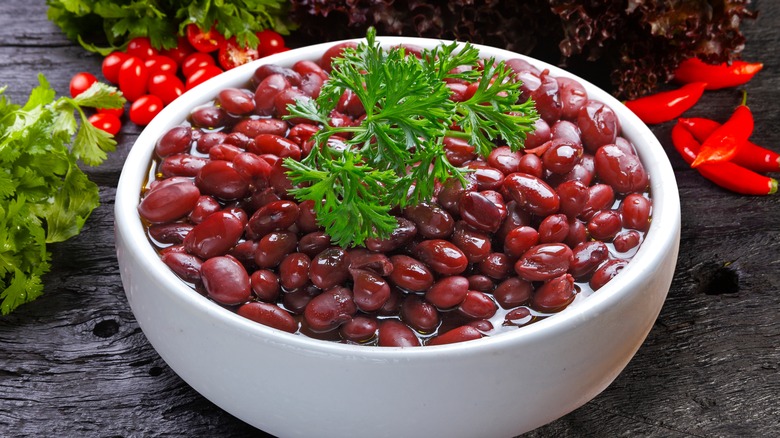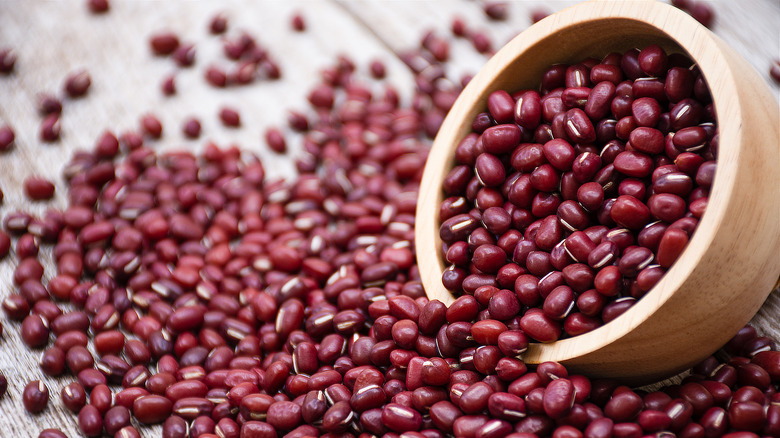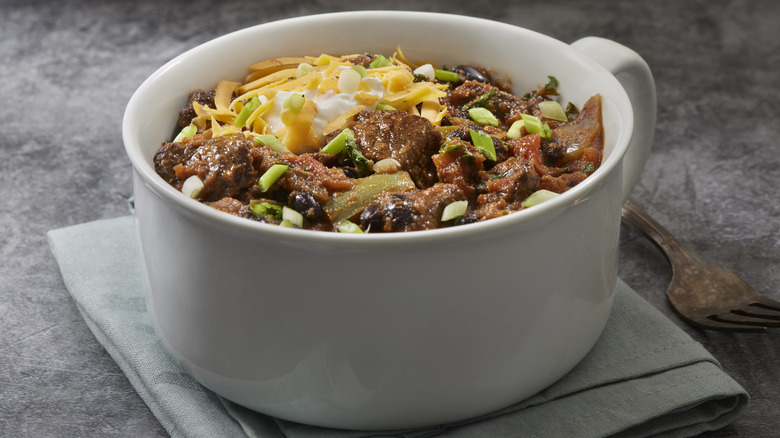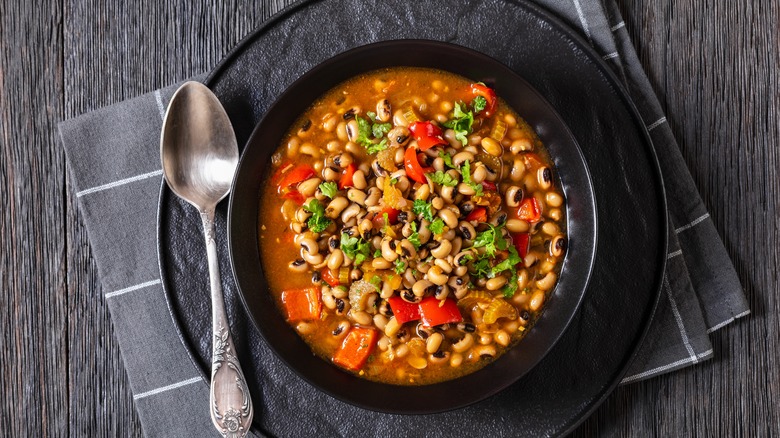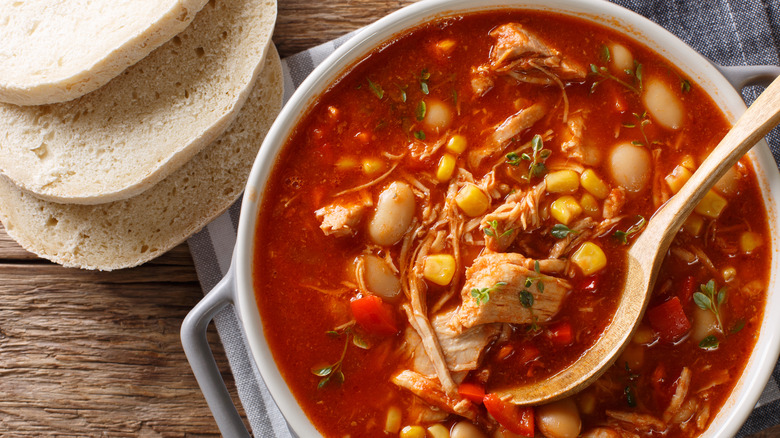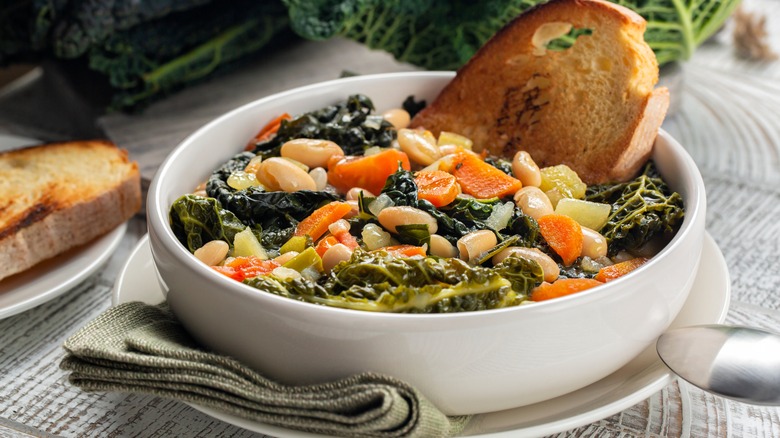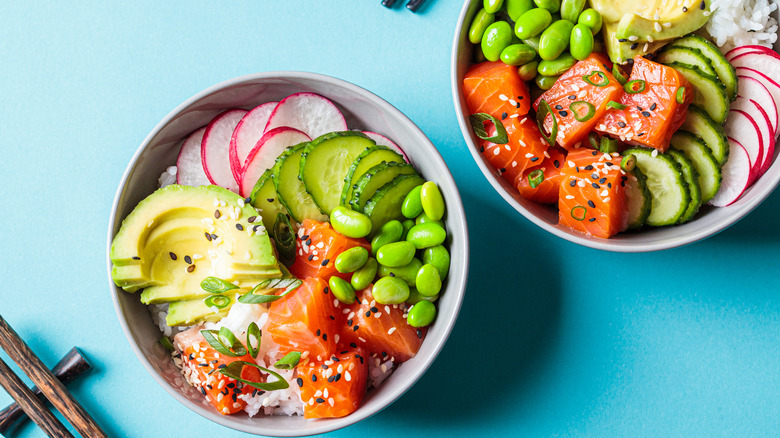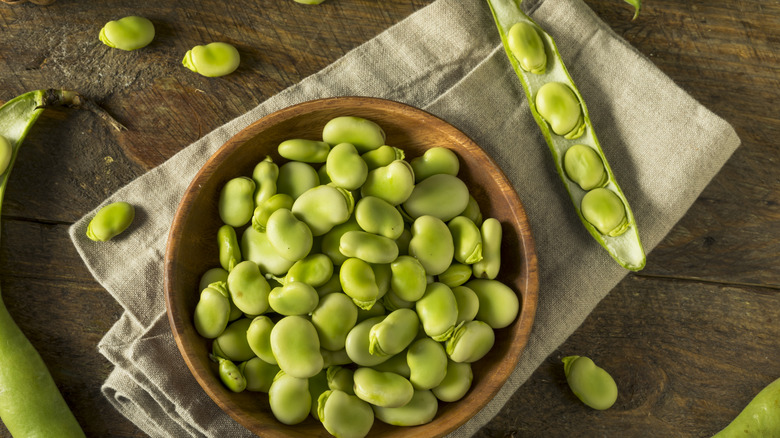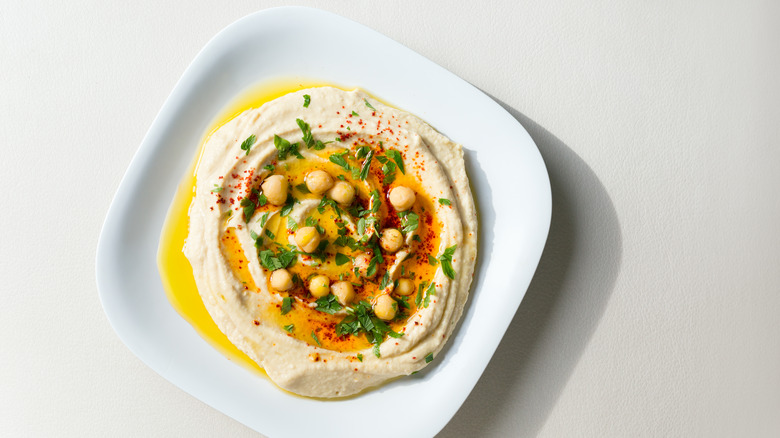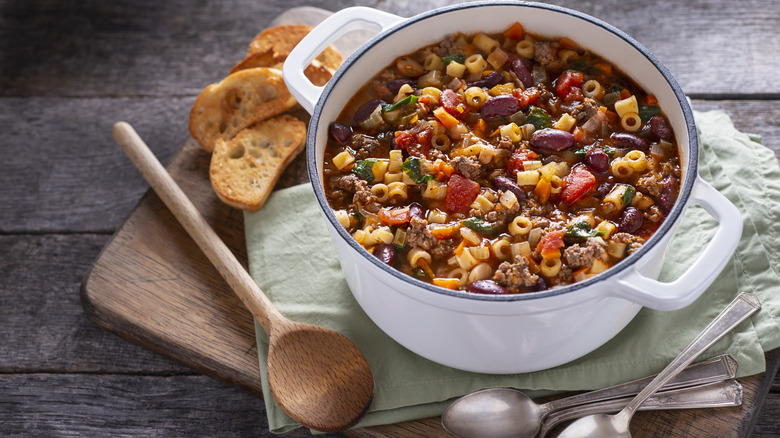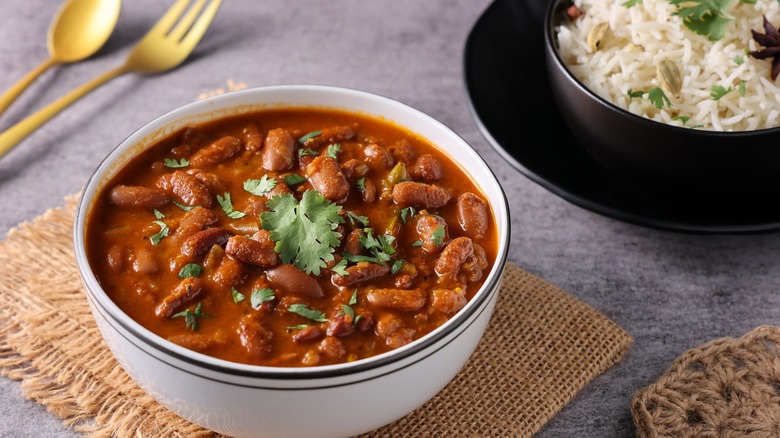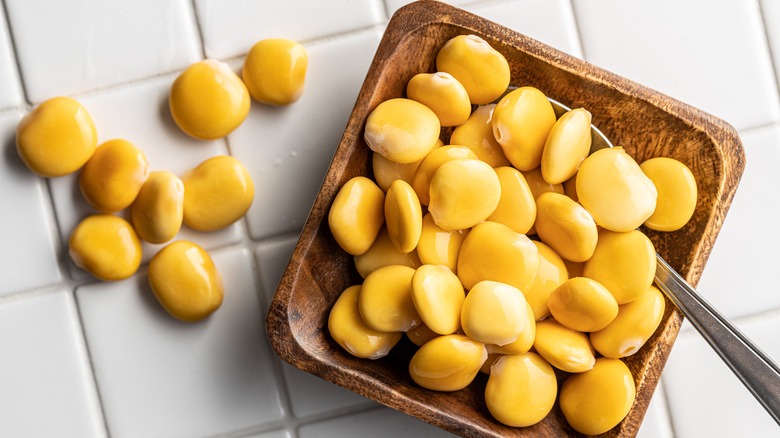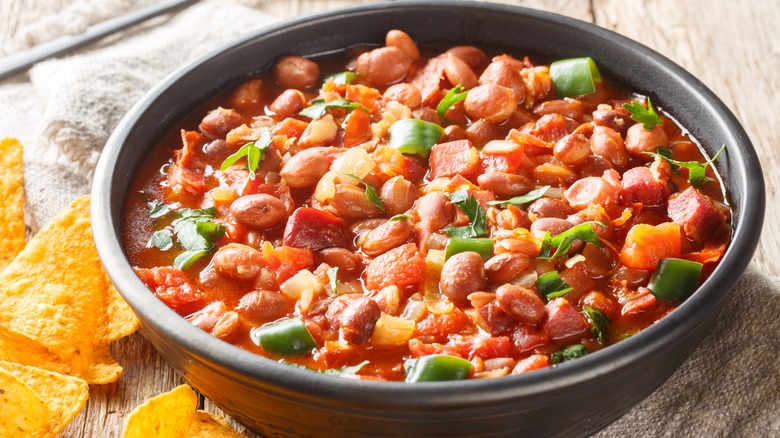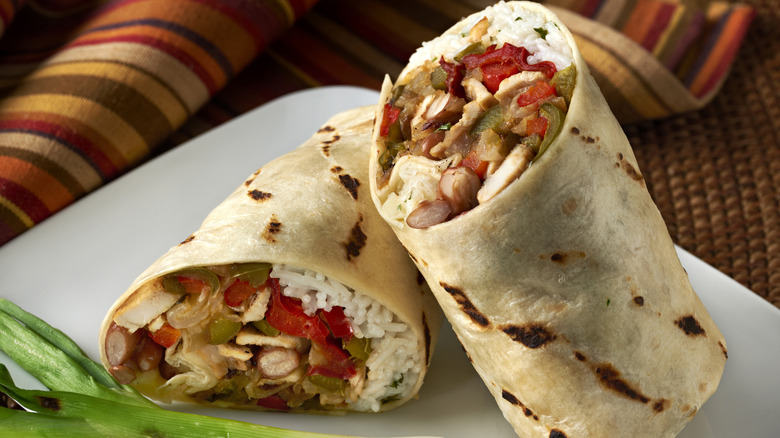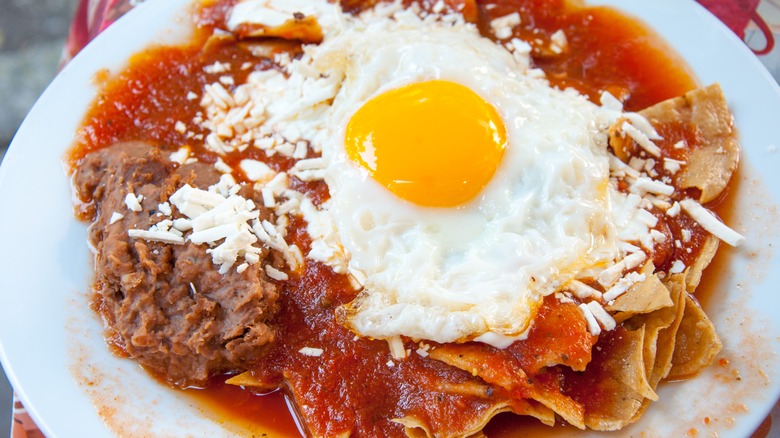The Top 14 Beans You Need In Your Pantry
It's been one of those days. You know the kind: Too much to do in too little time. Now, you're ready for dinner; all you lack is inspiration. The answer is in your pantry. In a can. Beans. Sometimes, we forget the obvious because we think of beans as something we leisurely soak, simmer, and enhance with chopped aromatics. Basil or ginger? Thyme or oregano? Both? Beans are the food we can cook most of the day as we enjoy the scent and the process and anticipate the final result. As wonderful as dried beans are, canned beans can play a big part in your cooking and your life. They're guilt-free, budget-friendly, always on hand, nutritious, and with the right enhancements, they're delicious.
Want an instant chili? Reach for the beans. Craving hummus, a nutritious soup, an on-the-run bean-and-cheese quesadilla? Stock your pantry with beans, and you'll never have to worry about a lack of inspiration, a last-minute meal, or a too-tired-to-cook night. Here are 14 types of beans you should always have in your pantry.
Adzuki beans
If you've ever eaten anything made with red bean paste, you've already tasted adzuki beans. They're the main ingredient in that sweet, earthy paste. Adzuki beans are a hybrid East Asian bean crossed with a Himalayan variety. Because they're more alkaline than other beans, they're popular with those following a macrobiotic diet. Some chefs substitute them for black beans in brownies. Like many beans, adzuki beans add sweetness and a creamy texture to your favorite hummus recipe.
If you have leftover ham or beef, add rinsed adzuki beans, smoked paprika, Sriracha, onions, mushrooms, and broth for a hearty bean stew that will be ready in minutes. If you want to cool off a hot summer day, combine adzuki beans with brown rice, carrots, cabbage, toasted sesame seeds, miso dressing, and cilantro for a refreshing bean bowl. Whether appetizer, main dish, soup, salad, or dessert, adzuki beans will soon earn their place in your pantry.
Black beans
Whether it's Meatless Monday, Taco Tuesday, or any other day, black beans will rescue you from a weekday rut. Open a can of black beans while you're sautéeing chopped onions and garlic, and you're already on your way to a satisfying meal. Consider chopping some leftover steak, tofu, or other protein into a can of black beans, chopped onions, and peppers. Black beans are hearty enough to stand alone in any dish. They play well with other beans, too. If you're feeling creative, combine them with cannellini beans, diced tomatoes, and butternut squash for vegetarian black bean chili. Add bell peppers, wine, and oregano for Cuban black beans. Or, if you're really pressed for time, heat the beans and stir in some salsa. Spread on a flour tortilla and add grated cheese for an almost instant quesadilla.
Eating beans for breakfast has long been a tradition in some cultures. Scrambled eggs with black refried beans and a little queso fresco can make your breakfast the ultimate comfort food. And don't forget your salad options. You can combine rinsed black beans with avocado, cherry tomatoes, herbs, zucchini, and nuts for a layered black bean salad.
Black-eyed peas
What do you think about when someone mentions black-eyed peas? New Year's luck, right? But black-eyed peas are great any day of the year and can add a taste of the South to even the simplest meal. Add chorizo, carrot, garlic, and vinegar for a power meal you don't have to spend hours cooking. You can't get much more Southern than black-eyed peas and bacon, and with Hoppin' John, you'll get both. All kinds of stories attempt to explain how the dish got its name, including one that says Hoppin' John was named after an old man who "hopped around" while selling rice and peas in Charleston. The basics of this dish include onion, garlic, celery, and smoky ham hocks. That's the traditional New Year's Day version, but you can vary it by omitting the meat and adding red bell pepper, parsley, and broth for a quick meal.
You can make that meal happen even faster if you take those Hoppin' John ingredients and create a Hoppin' John salad, with pea sprouts and hot bacon dressing. If you're ready to invest a little more time, add cornmeal, thyme, pepper, and onion, and turn those black-eyed peas into crispy, pan-fried fritters. Keep canned black-eyed peas on hand, and you won't have to wait for New Year's to enjoy them.
Butter beans
Like many foods, these potassium- and calcium-rich beans answer to more than one name. As is often the case, what you call them comes down to geography, so you have butter beans in the U.K. and the South. In the rest of the U.S., they're lima beans, as in Peru. You may have grown up with them as a side dish. Succotash, made with corn, butter beans, and often okra and bacon, originated in New England and is said to have been on the menu for the first Thanksgiving. Roughly translated, its name means "broken corn kernels."
Start with canned butter beans and black beans as the base for a classic succotash. Brunswick stew, a traditional Southern dish, combines beef, pork, or chicken with a spicy sauce of ketchup and/or barbecue sauce. Liven the bland taste of the beans with caramelized onion and balsamic vinegar. Add garlic, basil, lemon juice, and olive oil for a sweet, creamy, light green hummus that will hold its own against those made with chickpeas. All you need is pita bread.
Cannellini beans
Cannellini beans. The musical name is fun to say and suggests Italian cuisine ahead. These beans actually originated in Argentina, and Italian immigrants brought them to Italy, where they are grown today. They are larger than most white beans, similar in shape to kidney beans, and are sometimes called white kidney beans. They're not as creamy as the smaller great northern beans, which makes them a good match for soups and stews.
If you're craving comfort food — and instant gratification — add chopped tomatoes, vegetables, hot broth, and, yes, pasta to your beans and create a savory minestrone. Add carrots, tomato paste, kale, white wine, and broth, and you'll dine on Tuscan white bean soup. Add stale bread to thicken it, and you'll have ribollita soup. The versatility of these beans goes beyond Italian. You can substitute them for French beans in a cassoulet or combine them with smoked paprika, onion, garlic, and tomato paste for Spanish tapas.
Edamame beans
Having edamame beans in your pantry opens the door to new possibilities, even if your cooking time is limited. These whole immature soybeans gained popularity with vegans, and many of us limit our encounters with them to Asian restaurants, where they are often steamed in the shell and served as appetizers. Don't let your lack of familiarity keep you from enjoying them in other dishes as well. Buy them either canned or frozen, and use them the same way you would any other beans.
Mashed with lemon juice and wasabi paste, they'll add creaminess and flavor to a wasabi and edamame schmear. If you think poke salad is available only when dining out, you'll change your mind when you have edamame beans as close as your pantry. Some other ways to spice them up include adding them to a stir fry or a grain bowl with teriyaki sauce and rice.
Fava beans
Don't tell Hannibal Lecter that these are favorites for vegetarian dishes — although, like Hannibal's favorite meal, they are still excellent with a nice Chianti. You may have also heard these called broad beans, which are the larger, flatter variety. The canned beans come with their thick outer skin removed, saving you yet one more step when you're in a hurry to cook. Season and smash them on toast the way you would an avocado. Or add avocado to your bean mixture. Add mint or oregano and an egg if you're in the mood.
The nutty mild taste of fava beans makes them perfect for dips. You're right if you think they sound a lot like chickpeas. Their flavors are similar, and fava beans can easily be substituted for chickpeas in hummus or other dishes like fava bean falafel. They're also a quick way to add extra flavor and protein to a salad of fresh vegetables like cucumber, fennel, or both.
Garbanzo beans
Call them chickpeas or call them garbanzos — or if you want to get scientific, call them by their scientific name, cicer arietinum. Regardless of how you say it, remember them when you're looking for a shortcut to delicious creations. When you think of garbanzo beans, the first thing that comes to mind may well be hummus. A great hummus makes a perfect appetizer, snack, or light meal. You only need garlic, lemon, maybe a little tahini, and something to dip in or spread it on. Pita bread, perhaps. Or fresh vegetables.
If you're vegan, vegetarian, or want a break from meat, mash garbanzo beans with chopped celery, red onion, vegan mayo, and Old Bay seasoning. You'll have a faux tuna mix you can spread on bread or scoop on lettuce. Salads are a natural complement to garbanzo beans. Rinse, dry, and season them with garlic powder, cajun seasoning, or smoked paprika. Then roast the seasoned garbanzo beans until crispy and use them in place of croutons on a salad.
Great northern beans
Although they're also known as "common beans," there's nothing common about great northern beans. Make a Tuscan white bean pasta with macaroni, tomatoes, spinach, and lots of Parmesan. Or a white bean and ham soup. These beans are similar to white navy beans but are a little bigger and have an oval shape. Creamier than cannellini beans with a nutty flavor boost, great northern beans will add delicacy to your standard bean dip. They're the perfect bean for white-bean chili, with or without turkey or chicken. They are also ideal as one of the three beans in a three-bean salad. Just make sure you add plenty of crunch with cucumbers, red onion, and celery. Or give that bean salad a Southwestern vibe by adding cilantro, minced red onions, chipotle powder, and lime juice. If you have corn on hand, you can add that too.
Great northern beans also make an outstanding stuffing for the holidays or when you want something special. Combine them with your usual sausage ingredients, and consider adding dried fruit, sourdough or French bread, sausage, nuts, and broth.
Kidney beans
Kidney beans were named because of their red color and their shape, a vague resemblance to the human kidney. And they are a source of many good things — fiber, protein, iron, phosphorous — for your entire body. When you crave satisfying red beans and rice but lack time, reach for a can of kidney beans. These beans are a natural for the traditional New Orleans dish. Long before we named food after days of the week (like tacos on Tuesday), red beans and rice were a Monday tradition in the South for practical reasons. The Southern practice of Sunday supper meant lots of leftovers, including ham, for Monday cooking. You don't need leftovers to make a quick, satisfying red beans and rice meal. Just substitute bacon for the ham. Then add rinsed, drained kidney beans, corn, broth, bell pepper, and long-grain rice.
These versatile beans aren't just for Southern dishes. They also stand out in less traditional dishes like kidney bean curry, also known as rajma, the bean's Indian name. This curry dish has many variations, but all combine kidney beans with turmeric, garam masala, ginger, and tomatoes. Some include heavy cream.
Lupini beans
Coming home after a long day with no idea what to cook for dinner is no fun. Coming home to marinated, flavorful beans that are almost ready to eat is a different story. When you want a delicious snack, reach for the lupini beans. Although not as common as other beans, they are popular in Spain as altramuces, and in Portugal as tremoços. These flat, chewy beans are similar in shape to lima or fava beans. Like soybeans, they are a complete source of protein and are packed with nutrition. Because the dried beans are bitter and tough, cooking them to the edible stage is a process, but you can save time by buying them ready-to-eat jarred, canned, or vacuum-sealed.
Lupini beans are instant appetizers. Combine them in a blender with freshly roasted garlic cloves for a delectable hummus. Spice them up with chili powder and lime juice. Enjoy them cold or put them in the air fryer. Olives are a natural complement to these beans. Add green olives the way they do at the outdoor markets in Nice. Or prepare them like Italians do at Christmas, adding Castelvetrano or black olives to the beans.
Pinto beans
If there were a bean popularity contest, pinto beans would probably win. They're like old friends waiting to help you whip up an easy, delicious meal in record time. Frijoles charros are part stew, part soup, and you can put the dish together in minutes with fire-roasted tomatoes, green chiles, and pinto beans, all from cans on your pantry shelf. Pinto beans are ideal beans for nachos. Mash them slightly and layer with any meat you have on hand, melted cheese, guacamole, and salsa. Pinto beans are equally delicious on Mexican pizza, and if you keep frozen pizza crusts on hand, you can still have a home-cooked meal without investing a lot of time.
Craving enchiladas? Reach for the pinto beans. Craving tacos or tostadas? Pinto beans are the answer. And then, there's chili. For slow-cooker chili, you can add ground beef, tomatoes, canned pinto beans, and the rest of your ingredients early in the day. When you're ready — and hungry — serve it with rice, cornbread, or on its own.
Red beans
Some delicious meals are as simple and effortless as opening a can of beans. When that can contains red beans, you get to decide from numerous menu possibilities. Aren't red beans and kidney beans the same? Technically, no. Red beans are smaller and have a rounder, less kidney-like shape. However, they are similar in appearance and flavor and can be interchanged for each other in recipes. These beans stand out in traditional red beans and rice. Canned beans and pre-cooked, frozen rice allow you to make that dish in record time. For a Spanish flavor, combine the red beans with sweet smoked Spanish paprika, tomatoes, oregano, and wine, preferably sherry.
Do you have leftover rotisserie chicken you don't want to look at one more night? Combine it with green peppers and pre-cooked rice for a fajita wrap burrito. You only need to sauté the vegetables, heat the rice, and open a can of red beans.
Refried beans
Why would you buy canned refried beans when refried beans are so easy to make from scratch? Because sometimes you simply don't feel like mashing them yourself. Dress them up, and no one will know the difference. Do it right, and the beans might even taste better than homemade. Take breakfast, for instance. In minutes, you could be sitting down to chilaquiles, and the whole prep won't take much longer than frying the egg you slide on top of your beans, tortillas, and melted cheese. "Breakfasts" like this are just as satisfying for a late lunch or for dinner.
If you're going for something basic like a bean dip, liven up your refried beans with cumin, dried chiles, oregano, smoked paprika, or cilantro — and then stir in or spread your salsa over the top. Invest a little more work and a tortilla, and then turn those refried beans into a base for burritos, quesadillas, or tacos.

